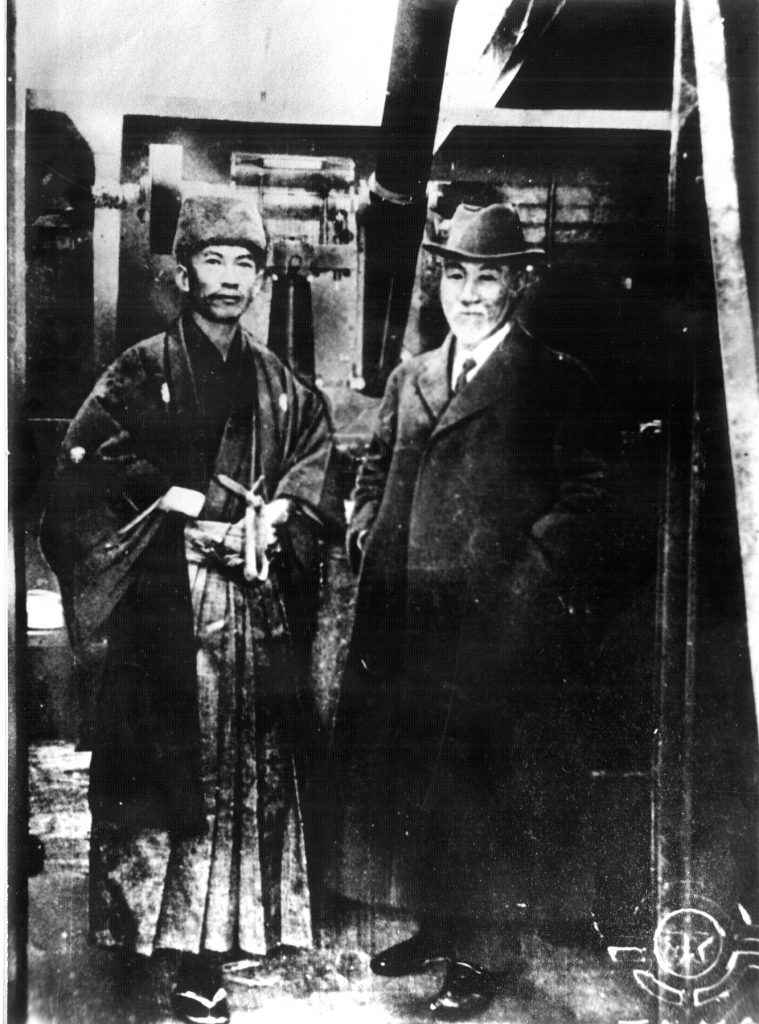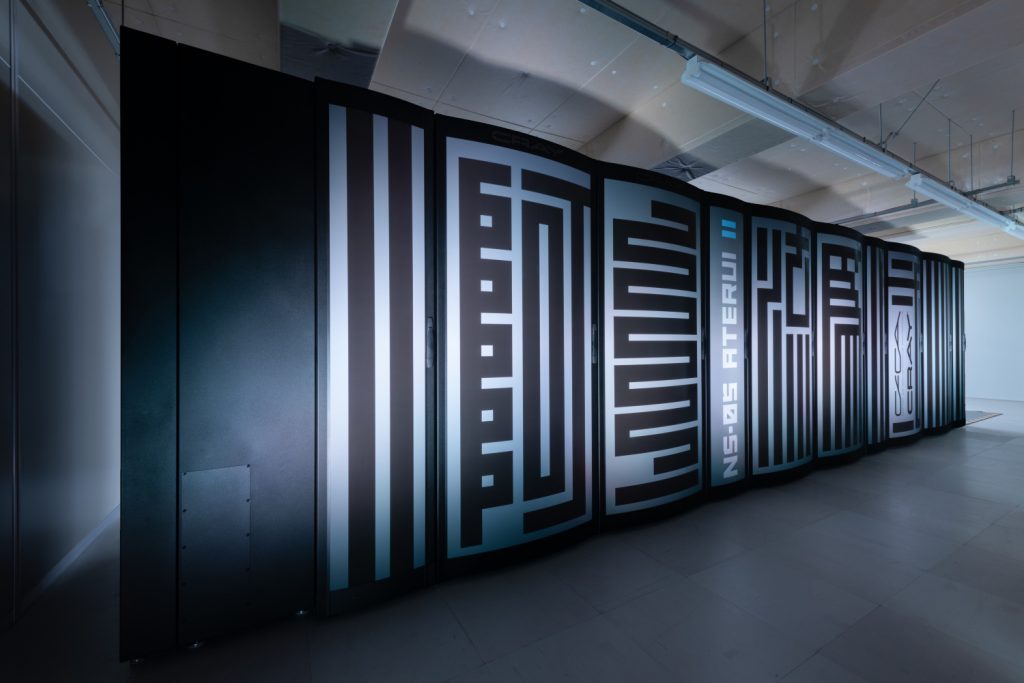This article was written by the Southern Iwate Regional Development Bureau, and translated by Amanda Wayama.
In April 2019, humankind took its first photograph of a black hole. One of the facilities that greatly contributed to that project was the National Astronomical Observatory of Japan in Mizusawa, a district in Oshu City, Iwate Prefecture.
In this issue, the researchers at NAOJ Mizusawa have helped us out to put together an article on the 120 years of history and achievements of the facility since its founding, as well as the various projects it’s working on currently.
NAOJ Mizusawa over the 120 years since its founding
By Ishikawa Toshiaki, Research Engineer at the Mizusawa VLBI Observatory, NAOJ
Last year marked the 120th anniversary of the founding of the Mizusawa Temporary International Latitude Station, the original facility built in 1899 that eventually went on to become the Mizusawa VLBI Observatory at NAOJ.
In the latter half of the 19th century, researchers in the United States figured out from their astronomical observations that the Earth tended to wobble on its axis (a term called “latitude variation”). In order to solve the mystery, the International Association of Geodesy (IAG) decided to take measurements from 6 different places at the latitude of 39 degrees and 8 minutes north. As one of the candidate sites, Japan received a request from IAG to build an observatory in the country, and the Japanese government made the extraordinary decision to construct the International Latitude Station in Mizusawa. It was initially only supposed to be a temporary project ending in five years’ time, but Kimura Hisashi (the first director of the facility) discovered that there was an unknown variable in the earth’s latitude variation, which he called the z-term. This discovery led to a change in the world’s view of Japan, and the next challenge was to figure out why the z-term existed. That research continued for more than 80 years.
Once the reasons for the z-term were understood, the International Latitude Ovservatory of Mizusawa(ILOM) branched out into new fields of research. After it was reorganized into National Astronomical Observatory of Japan(NAOJ) Mizusawa, the facility worked on many things, such as creating detailed maps of the galaxy with the VERA array, and developing instruments of the Kaguya lunar probe as well as observations and scientific research. Observatory director Honma and other researchers are part of the Japanese team of the Event Horizon Telescope (EHT) project, which last year announced the first successful photograph of a black hole.
As a pioneer of astronomy and other related subjects, the NAOJ Mizusawa facility will continue to carry out research here, in this region selected by famous physicist Tanakadate Aikitsu and Kimura Hisashi.
Chronology of NAOJ Mizusawa
1899 ― Establishment of the Mizusawa Temporary International Latitude Station , and observations begin for the International Latitude Observation Service (ILS)
1902 ― Discovery of the z-term by Kimura Hisashi
1920 ― Mizusawa Station was reorganized into a permanent observatory
1922 -1935 ― Central Bureau of the ILS at Mizusawa
1962-1987 ―Central Bureau of the International Polar Motion Service (IPMS) at Mizusawa
1970 ― The reasons for the z-term are understood (Wako Yasujiro)
1971 ― The International Astronomical Union (IAU) sysmposium No.48 “Rotation of the Earth” was held in Morioka City
1980 ― ILOM releases results of the International Latitude Service in a Homogeneous System
1988 ― The ILOM was reorganized into National Astronomical Observatory of Japan (NAOJ) Mizusawa
1992 ― Construction of a 10m radio telescope is completed, and domestic observations for the VLBI network begin
2001-2002 ― The VERA array is completed
2007-2009 ― VLBI observations of the Kaguya (SELENE) lunar probe
2013 ― The supercomputer ATERUI is installed
2018 ― The supercomputer ATERUI II is installed
2019 ― Successful touchdowns of the Hayabusa2 spacecraft onto the asteroid Ryugu
2019 ― Release of the image of the M87 giant black hole by the Event Horizon Telescope (EHT)
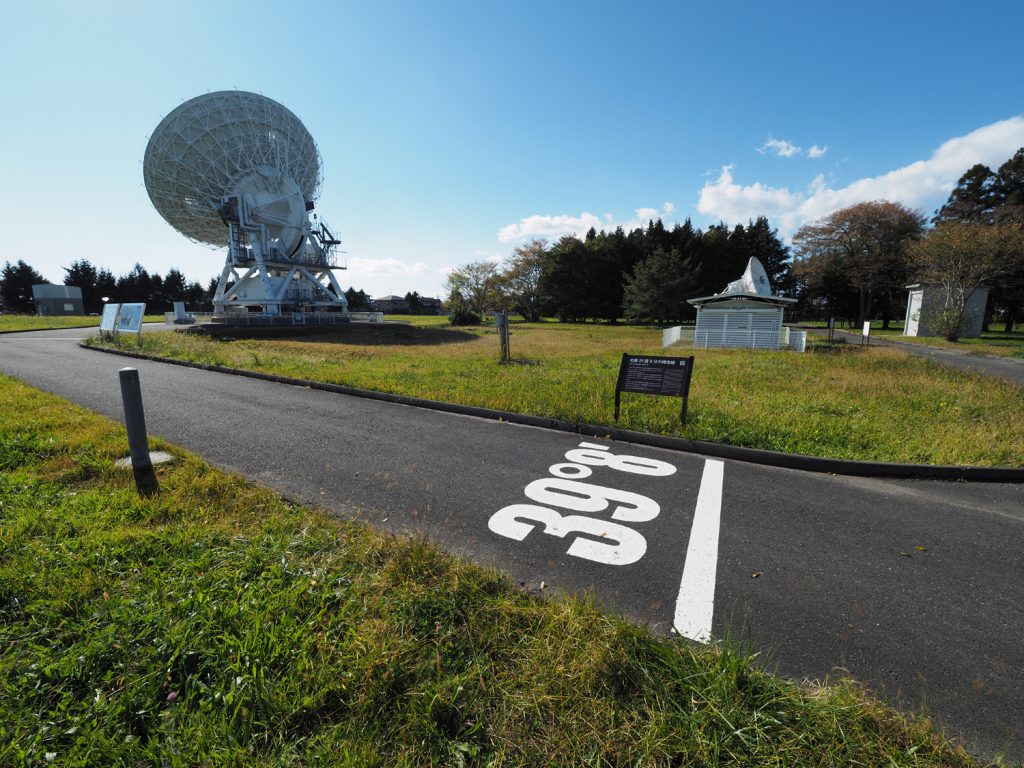
The environs at NAOJ Mizusawa. Here is the VERA 20m antenna, and you can also see the former zenith telescope room from 1899 at the 39°8′mark(Credit: NAOJ)
VERA(VLBI Exploration of Radio Astrometry)
By Professor Honma Mareki, Director of the Mizusawa VLBI Observatory, NAOJ
The Mizusawa VLBI (Very Long Baseline Interferometry) Observatory of NAOJ operates the VERA (VLBI Exploration of Radio Astrometry) array consisting of four radio observatories, which also includes ones in Satsuma-Sendai City (Kagoshima Pref), Ogasawara Village (Tokyo), and Ishigaki City (Okinawa Pref) in addition to the one in Ohshu. Construction began in 2000, and these facilities have been continuously operated since 2002 when they were completed. In the first picture below, you can see the 20m radio telescope and night sky at the Mizusawa VLBI Observatory.
The VERA array observes maser objects (mostly places where young stars are formed) within the Milky Way Galaxy. VERA makes observations day and night, because by measuring distance and movement over more than a year’s time, we can figure out the size of the galaxy, the speed of its movement, and the distribution of dark matter within the Milky Way. VERA has already recorded the distance and movement of more than 100 celestial objects, and with results from US and European telescopes, we can clearly see the distribution of maser objects and their movement within the Milky Way (picture 2). Through this, we can obtain a basic scale of the Milky Way, such as the distance to its center and the speed of its rotation. Research is on-going to reveal the distribution of dark matter and the structure of the Milky Way’s spiral arms.
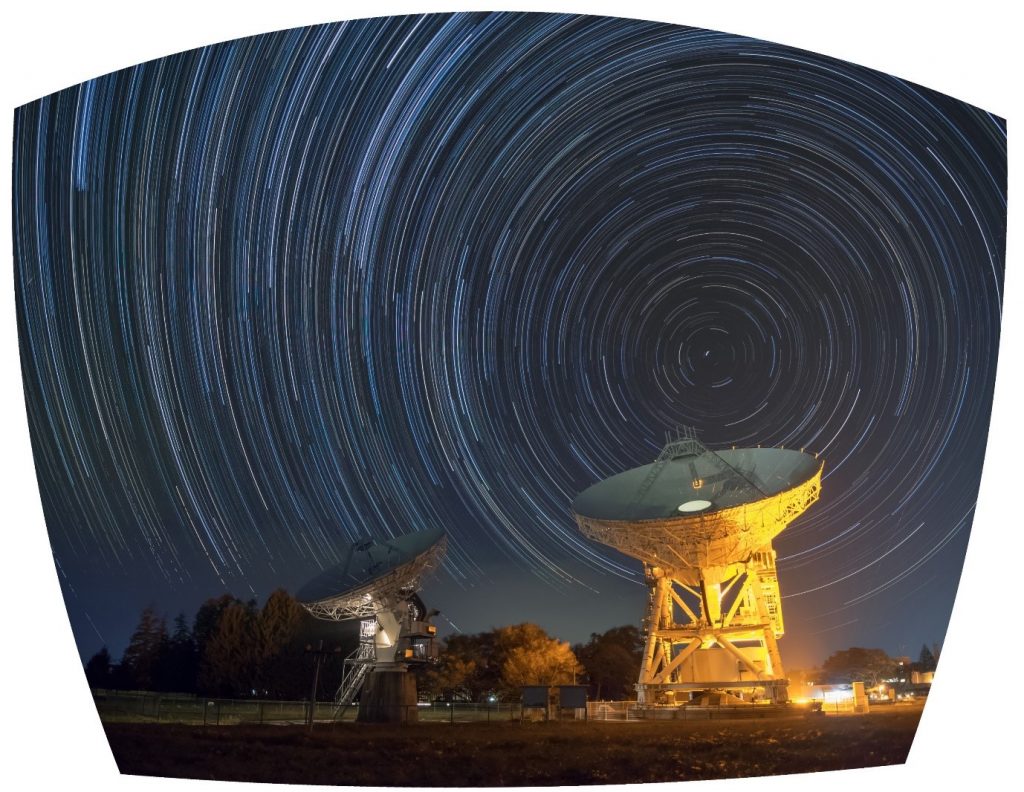
Picture 1: The 20m radio telescope (right) at NAOJ Mizusawa VLBI observatory, as well as the movements of the northern stars (Credit: NAOJ, Photo taken by: Iijima Yutaka)
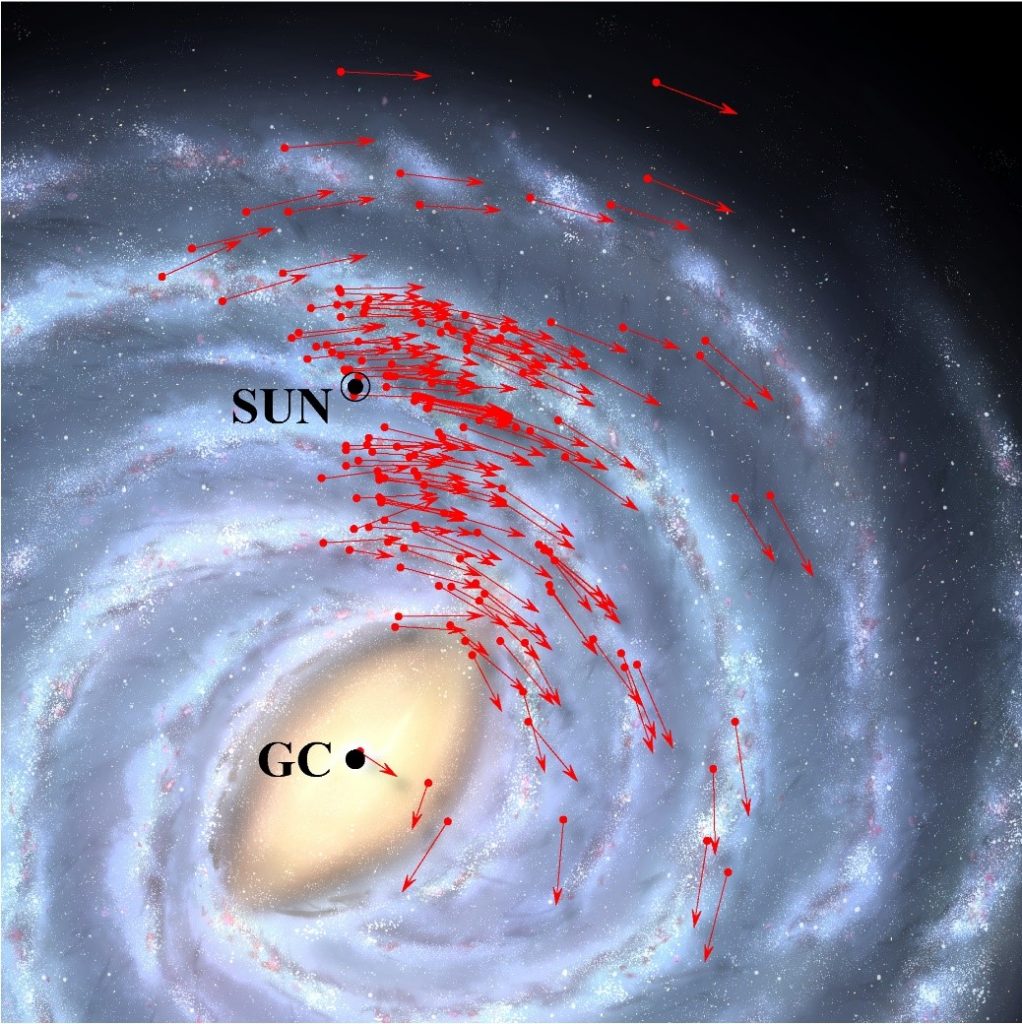
Picture 2: With VERA’s observations, the distribution of maser objects and their movements become clear (point and arrows). The spiral arms in the background are a conceptual drawing.(Credit: NAOJ)
RISE Project
By Assistant Professor Noda Hirotomo, RISE Project, NAOJ
Our project has inherited Mizusawa’s tradition of geodesy with its research into the solar system’s planets, asteroids, moons, and more.
10 years ago, in the Kaguya Lunar Exploration Program, we developed and operated scientific instruments that measured the lunar gravity field and terrain. The name for the RISE project at that time was taken from the term Research in Selenodesy (measuring the shape, orientation and gravity field of the moon), but after the Kaguya project, we expanded our research field to the celestial bodies within the solar system, and the term now stands for Research of Interior Structure and Evolution of solar system bodies – a keyword for our work.
For around one and a half years from 2018 to 2019, the Japanese spacecraft Hayabusa2 explored the asteroid Ryugu, and we fulfilled a central role in developing and operating a laser altimeter aboard, one of four scientific instruments on the probe.
We have ended mapping on the asteroid, and now scientific research will take center stage. We are working on projects that aim to solve the mysteries of the universe’s celestial bodies, like the Japanese MMX (Martian Moons eXploration) project that works to survey the moons of Mars, and the European JUICE (Jupiter Icy moons Explorer) project that works to survey the icy satellites of Jupiter.
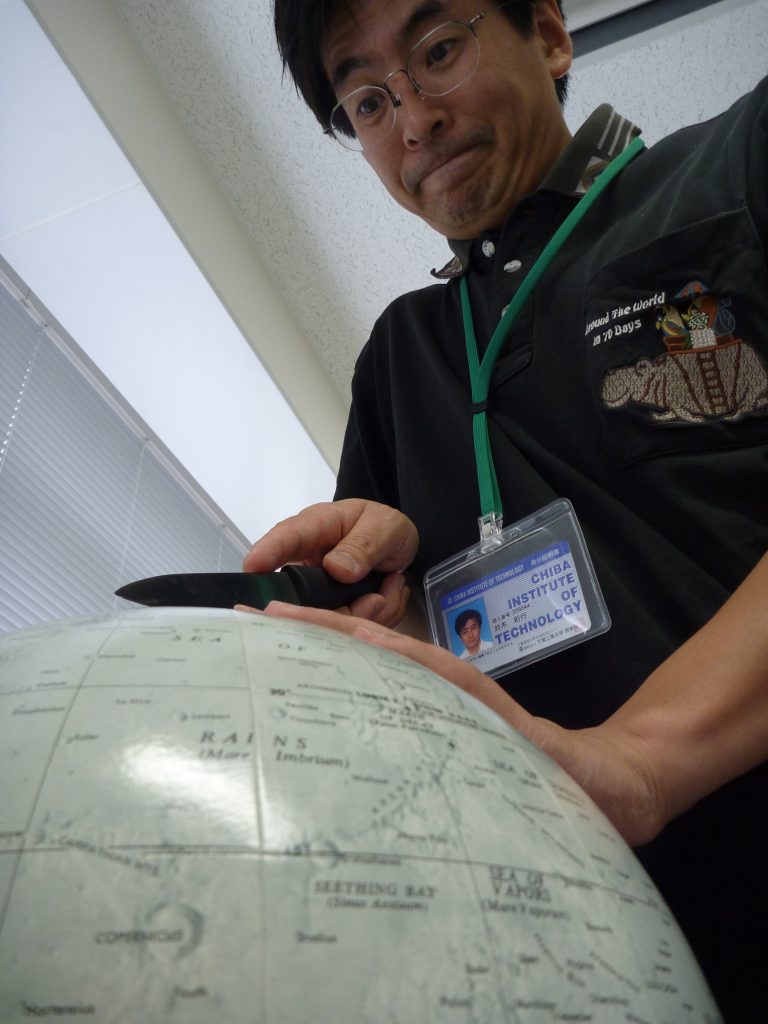
Project Director Namiki wants to learn about the moon so bad that he’s trying to cut it clean in half (Credit: NAOJ)
ATERUI Ⅱ
By Dr. Fukushi Hinako, Senior Specialist at the Center for Computational Astrophysics, NAOJ
Currently in the field of astronomy, along with observations and theoretical studies, astronomical simulations are our most crucial tools – calculations based on the laws of physics to create experiments of celestial phenomena within computers.
NAOJ Mizusawa has a supercomputer dedicated to astronomical simulations, “ATERUI II”. It’s capable of three quadrillion calculations per second, the world’s fastest supercomputer for astrophysical simulations. Astrophysicists at home and abroad access this computer for conducting simulations of various astronomical phenomena. ATERUI II can make large-scale calculations about how, for example, the structure of the Universe evolved in the 13.8 billion years since its beginnings. In addition, ATERUI II contributed to research for the imaging of the black hole by simulating and predicting how light would travel around it.
The word “Aterui” is the name of a hero of the Mizusawa area who lived around 1,200 years ago. We named this supercomputer ATERUI hoping that it would bravely challenge to solve the mysteries of the Universe. It has been 120 years since Kimura Hisashi made his calculations using an abacus, and now in that same Mizusawa area, ATERUI II updates our understandings of the Universe by simulations.
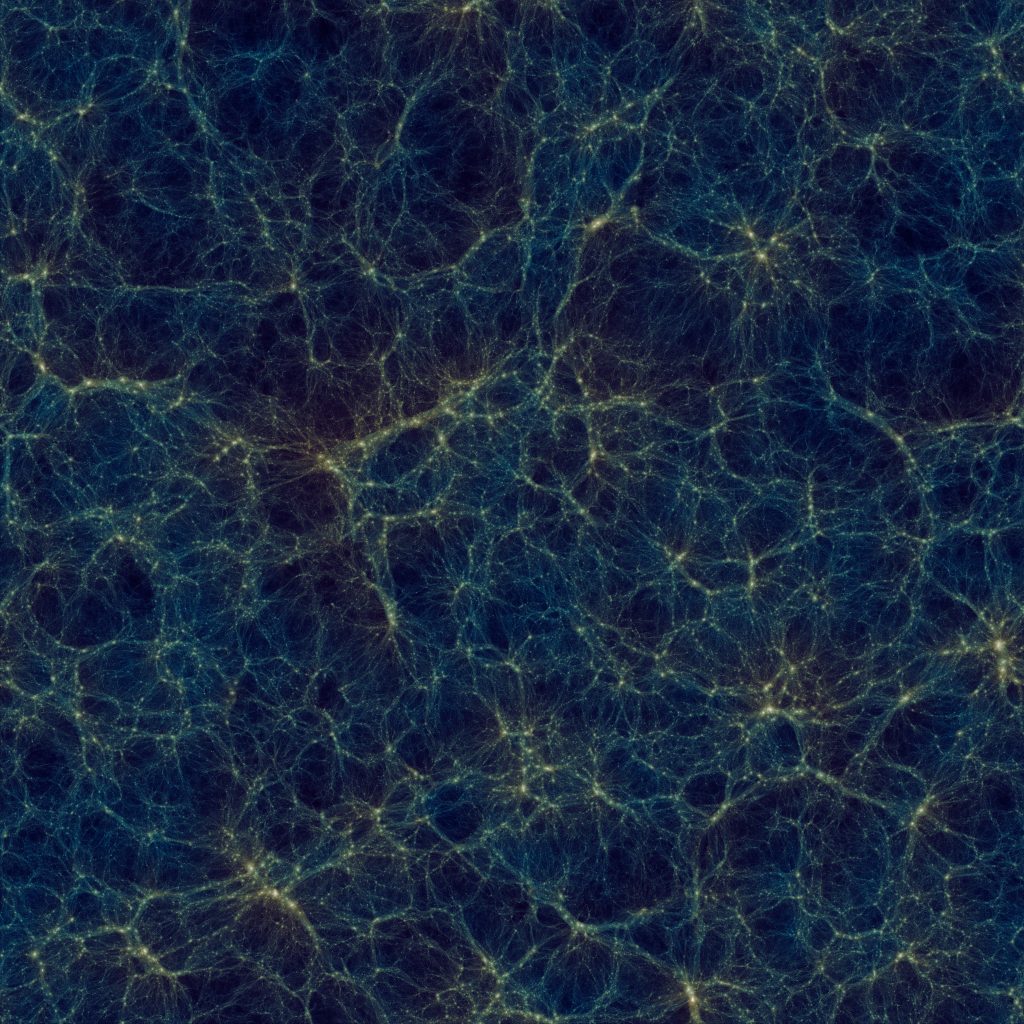
A simulation of the large-scale structure of the universe (Credit: Ishiyama Tomoaki/Chiba University)
EHT(Event Horizon Telescope Collaboration)
By Dr. Tazaki Fumie, Specially Appointed Research Staff at Mizusawa VLBI Observatory, NAOJ
In April 2019, news spread around the world that humankind had taken its very first picture of a black hole. Ever since Einstein proposed the theory of general relativity, we had theorized the existence of black holes, which are bodies with gravitational fields strong enough to swallow even light. However, with this photo, we had finally got irretrievable proof of the shadow of the black hole (the black portion of the picture). Now that scientists have taken the first photo in human history of a black hole, the curtain has opened on a new era of black hole research.
The picture is of a giant black hole at the center of an elliptical galaxy within the Virgo constellation called M87. The Event Horizon Telescope (EHT) that took the picture is the combination of 8 radio telescopes in 6 places across the world, forming a telescope the size of the globe. This achieves an excellent resolution to take a picture of the black hole very far away, whose apparent size is same as a tennis ball on the moon. Over 200 researchers from around the world worked together for over ten years to achieve this. There were thirteen from Japan who were involved with the projects, and five of us were at Mizusawa. We were involved with developing and operating observation devices, and creating images from the observation data.
We understand that there is a current of plasma flowing from the giant black hole in M87, called a jet. A telescope that’s particularly suited for researching this jet would be the EAVN (East Asian VLBI Network). By combining radio telescopes in Japan, South Korea, and China, we can form a giant radio telescope the size of East Asia. The 20m radio telescope in Mizusawa is one of those telescopes. At Mizusawa VLBI Observatory, we will use the technological prowess and research power available through joining up with the telescopes around the world, and continue to research black holes with the EHT and EAVN.
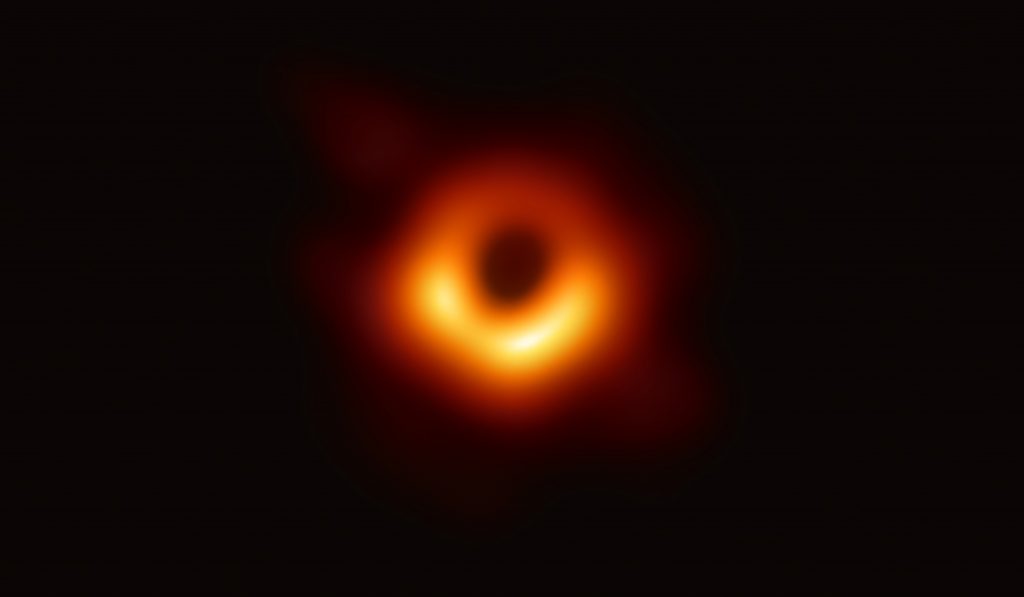
Photo 1: The photo of the M87 giant black hole taken by the EHT(Credit: Event Horizon Telescope Collaboration)
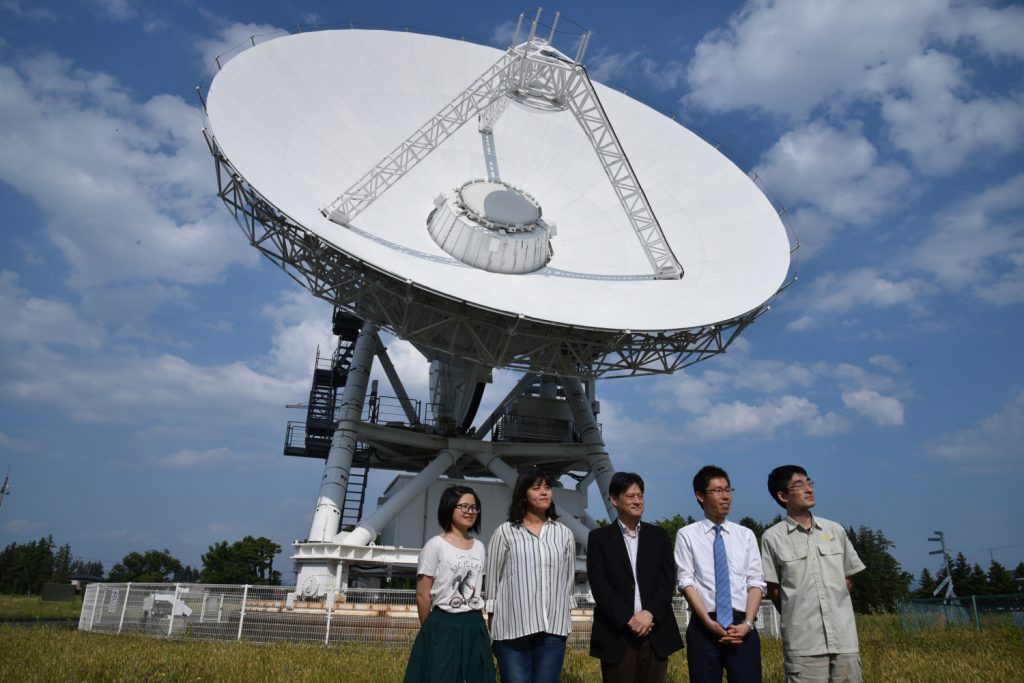
Photo 2: The Mizusawa members of EHT. Taken in front of the 20m radio telescope at the observatory(Credit: NAOJ)
===
How did you like this article?
Should the ILC be realized, it will be able to work with NAOJ Mizusawa along with the Oshu Space & Astronomy Museum (site of the former Mizusawa Latitude Observatory), and we think it will become a hub for scientific research and exchange in the region. We’re really looking forward to it.
We want to give a big thanks to the folks at NAOJ Mizusawa for their cooperation. Best wishes for your continued success!
Japanese
科学で世界とつながるまち 岩手県奥州市~国立天文台水沢 創立120周年~
岩手県奥州市には、2019年4月にブラックホールの撮影という国際プロジェクトに大きく貢献した「国立天文台水沢」があります。
今回は、その国立天文台の研究者の皆さまにご協力いただき、創立120周年という歴史と素晴らしい実績を誇る国立天文台水沢のこれまでの歩みや、現在関わっている様々なプロジェクトについて御紹介します。
創立120周年の歩み
国立天文台水沢VLBI観測所
石川利昭(いしかわとしあき) 研究技師
国立天文台水沢VLBI観測所は昨年、前身である水沢臨時緯度観測所として1899年に設置され緯度観測を開始してから120周年を迎えました。
19世紀後半、欧米では天文観測により地球がふらつきながら回転(緯度変化)することが分かり、その謎を解明するため、万国測地学協会(IAG)は北緯39°8′の緯度線上に6観測所を設置して観測することを決めました。日本もその候補地としてIAGから要請を受け、明治政府がなみなみならぬ決意のもとに設置したのが水沢臨時緯度観測所でした。当初は5年間で終わる事業でしたが、木村(きむら)榮(ひさし)(初代所長)が観測結果から緯度変化に未知の変化量(Z項)があることを発見したことにより、日本の評価は一変し、更にZ項の原因解明が課題となり、80年以上にわたって研究を続けて今日に至ります。
Z項の原因が解明された後、緯度観測所は研究活動を新たな分野へと広げ、国立天文台に改組転換後は、VERA電波望遠鏡による銀河系の精密な地図作り、月探査機「かぐや」の搭載機器開発と観測・研究などを行ってきました。昨年はイベント・ホライズン・テレスコープ(EHT)の日本チーム(水沢の本間所長と研究者がメンバー)がブラックホールの撮影成功を発表しました。
国立天文台水沢は天文学と関連分野のパイオニアとして、田(た)中舘(なかだて)愛(あい)橘(きつ)と木村が選定したこの地でこれからも研究活動を続けてまいります。
【 国立天文台水沢 略年表 】
1899 (明治32) 年 水沢臨時緯度観測所設置、国際緯度観測事業(ILS)開始
1902 (明治35) 年 Z項発見(木村栄)
1920 (大正 9) 年 臨時緯度観測所から緯度観測所へ
1922 (大正11) 年~1935 (昭和10) 年 国際緯度観測事業中央局を担当
1962 (昭和37) 年~1987 (昭和62) 年 国際極運動観測事業(IPMS)中央局を担当
1970 (昭和45) 年 Z項の原因解明(若生康二郎)
1971 (昭和46) 年 国際天文学連合シンポジウム“地球回転”開催(盛岡)
1980 (昭和55) 年 ILS 極運動統一再計算結果出版
1988 (昭和63) 年 緯度観測所から国立天文台水沢へ
1992 (平成4) 年 10m電波望遠鏡完成、国内VLBIネットワーク観測開始
2001 (平成13) 年~2002 (平成14) 年 VERA電波望遠鏡完成
2007(平成19)年~2009(平成21)年 月探査機かぐや(SELENE) のVLBI観測
2013 (平成25) 年 スーパコンピュタ アテルイ設置
2019 (平成31) 年 はやぶさ2 小惑星リュウグウへのタッチダウンに成功
2019 (平成31) 年 イベントホラズンテレスコープ(EHT)M87巨大ブラックホール撮像成功を発表
【写真】
国立天文台水沢の様子。VERA20mアンテナがあり39°8′の緯度線の向こうには1899年から緯度観測が行われた旧眼視天頂儀室が見える。(Credit:NAOJ)
【写真】
木村榮(左)と田中舘愛橘(右)(Credit:NAOJ)
VERA(VLBI Exploration of Radio Astrometry)
国立天文台水沢VLBI観測所 所長
本間希樹(ほんままれき) 教授
VERA(VLBI Exploration of Radio Astrometry)は水沢VLBI観測所が現在運用しているVLBI(超長基線電波干渉計)の観測網で、岩手県奥州市に加えて、鹿児島県薩摩川内市、東京都小笠原村、沖縄県石垣市の4カ所の電波望遠鏡からなる観測ネットワークです。2000年から建設が始まり、2002年に全局が完成して現在も運用が続いています。写真1は水沢VLBI観測所の20m電波望遠鏡と夜景の様子です。
VERAの観測網は天の川内にあるメーザー天体を観測し、1年以上の時間をかけてその距離と運動を測定することで天の川の大きさや運動速度、暗黒物質の分布などを明らかにするため日夜観測を続けています。VERAではすでに100を超える天体について距離と運動の計測が終了しており、米国やヨーロッパの望遠鏡による結果も合わせて、写真2のように天の川内のメーザー天体の分布や運動の様子がきれいに捉えられています。これによって、天の川の中心までの距離や回転速度などの天の川の基本尺度が求まり、また暗黒物質の分布や天の川の渦状腕の構造に関する研究も進みつつあります。
【写真】
写真1:国立天文台水沢VLBI観測所の20m電波望遠鏡(右)と、北天の星の動き。
(Credit: NAOJ, 撮影: 飯島裕)
【写真】
写真2:VERAなどの観測から明らかになったメーザー天体(若い星が生まれている現場)分布とその運動(点と矢印)。背景の渦巻は銀河系の想像図。(Credit:NAOJ)
RISE月惑星探査プロジェクト
国立天文台RISE月惑星探査プロジェクト
野田寛大(のだひろとも) 助教
水沢の測地学の伝統を引き継ぎ、太陽系の惑星、小惑星、月などの研究をしています。
今から10年前の月探査計画「かぐや」では、月の重力と地形を測定する装置をそれぞれ開発し、装置の運用や科学成果の創出を行いました。当時のRISEは「月の測地学」を意味するResearch in Selenodesyの頭文字をとっていましたが、「かぐや」終了後に研究対象とする天体を太陽系内の固体天体全体に広げて、「内部構造と進化」(Research of Interior Structure and Evolution of solar system bodies)をキーワードに活動するようになりました。
そして、2018年から2019年の約1年半にわたって小惑星「リュウグウ」の観測を続けた日本の小惑星探査機「はやぶさ2」では、4つの科学観測装置のうちの一つ「レーザ高度計」の開発や運用で中心的な役割を果たしました。
小惑星での調査は終わりましたが、これからはいよいよ科学研究が中心になっていきます。今後は、火星の月を探査する日本のMMX計画(Martian Moons eXploration)や、木星の氷衛星を探査するヨーロッパのJUICE(JUpiter ICy moons Explorer)で固体天体の謎に迫っていきます。
【写真】
写真:
月の中を知るために真っ二つに割ろうとしている並木プロジェクト長(Credt:NAOJ)
ATERUI Ⅱ
国立天文台天文シミュレーションプロジェクト
福士比奈子(ふくしひなこ) 特任専門員
現代天文学では、観測、理論とならび、物理法則に基づいた計算によってコンピュータの中に作り出し実験的に天体現象を調べる「シミュレーション天文学」が欠かすことのできない研究手法となっています。
国立天文台水沢キャンパスには、シミュレーション天文学のためのスーパーコンピュータ「アテルイⅡ」が設置されています。その性能は1秒間に3000兆回の計算をおこなうことができ、天文学専用スーパーコンピュータでは世界最速を誇ります。このアテルイⅡには国内外の天文学者がアクセスし、様々な天体現象のシミュレーションを行っています。例えば、宇宙が誕生してから現在までの138億年の間に、宇宙の構造がどのように進化するのかという大規模な計算が行われています。また、2019年4月に発表されたブラックホール・シャドウの研究にも、ブラックホール周辺の光の進み方をシミュレーション予測することで貢献しています。
アテルイとは、1200年ほど前に水沢の地で活躍した英雄の名前です。このスーパーコンピュータも宇宙の謎に果敢に挑んで欲しいという願いをこめて、愛称「アテルイ」と命名されました。木村榮博士がそろばんをはじいて計算していた時代から120年、現在水沢の地ではアテルイⅡが計算によって最先端の宇宙像を描きだしています。
【写真】
画像:https://www.cfca.nao.ac.jp/files/AteruiII_left_white.jpg
アテルイⅡ(Credit: NAOJ)
【写真】
画像:https://www.cfca.nao.ac.jp/files/c_ATERUI2.jpg
宇宙の大規模構造シミュレーション(Credit: Tomoaki Ishiyama/Chiba University)
EHT(Event Horizon Telescope Collaboration)
国立天文台水沢VLBI観測所
田崎文得(たざきふみえ) 特任研究員
2019年4月、ブラックホールの撮影に成功したというニュースが世界中を駆け巡りました。アインシュタインが相対性理論を提唱してから、光さえも吸い込む重力の強い星「ブラックホール」の存在が考えられてきましたが、ようやくその証拠であるブラックホール・シャドウ (画像中心の黒い部分) を捉えることができました。この人類史上初の画像を皮切りに、ブラックホール研究の新時代が幕を開けました。
捉えられたのは、おとめ座のM87という楕円銀河の中心にある巨大ブラックホールです。撮影したイベント・ホライズン・テレスコープ (EHT) は、世界6ヶ所8台の電波望遠鏡を組み合わせて、地球サイズの望遠鏡のような能力を発揮します。これによって、月の上のテニスボールを見るくらい、小さく見えるブラックホールを撮影できたのです。200名を超える世界中の研究者が協力して、10年以上の歳月をかけて達成しました。日本からは13名の研究者がプロジェクトに参加しています。そのうち5名が奥州市の水沢VLBI観測所に在籍し、観測装置の開発や観測運用、観測データからの画像化などを担当しました。
M87の巨大ブラックホールからは、ジェットと呼ばれるプラズマ流が噴出していることが知られています。このジェットを調べるのが得意な望遠鏡が「東アジアVLBI観測網 (EAVN)」です。日本・韓国・中国の電波望遠鏡を組み合わせて、東アジア全体を一つの巨大電波望遠鏡のような役割をします。奥州市水沢にある直径20メートルの電波望遠鏡も、EAVNの望遠鏡の1つです。水沢VLBI観測所では、これまで培ってきた世界中の望遠鏡を繋ぎ合わせる技術力や研究力を活かして、EHTとEAVNを使ったブラックホール研究を推進していきます。
【写真】
画像1:EHTで撮影されたM87巨大ブラックホールの画像。
(Credit: Event Horizon Telescope Collaboration
【写真】
画像2:EHT水沢メンバー。水沢VLBI観測所20メートル電波望遠鏡前で撮影。
(Credit: NAOJ)
いかがでしたでしょうか。
国際リニアコライダーが実現した際には、国立天文台水沢や奥州宇宙遊学館(旧緯度観測所)などとも連携し、科学を通じて、この地域が科学の研究拠点や交流拠点となっていくことが期待されます。とても楽しみですね。
国立天文台の皆さま、御忙しいところ御協力いただきありがとうございました。今後益々の御活躍をお祈りします。


